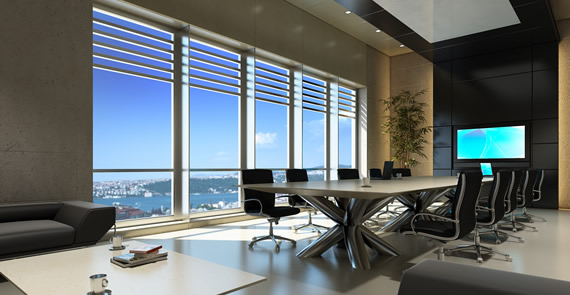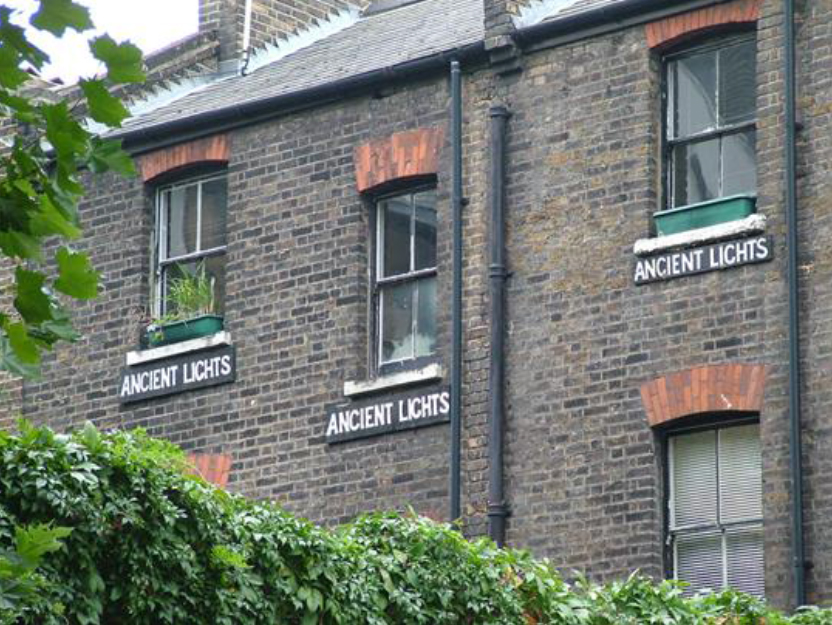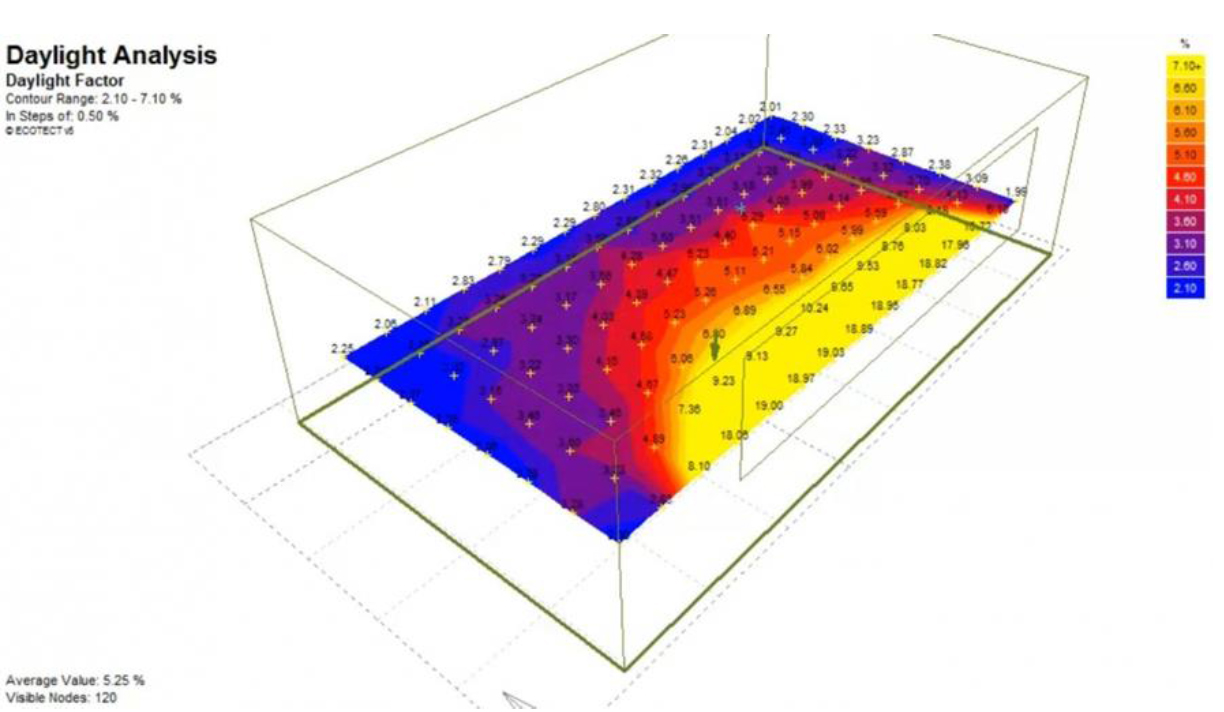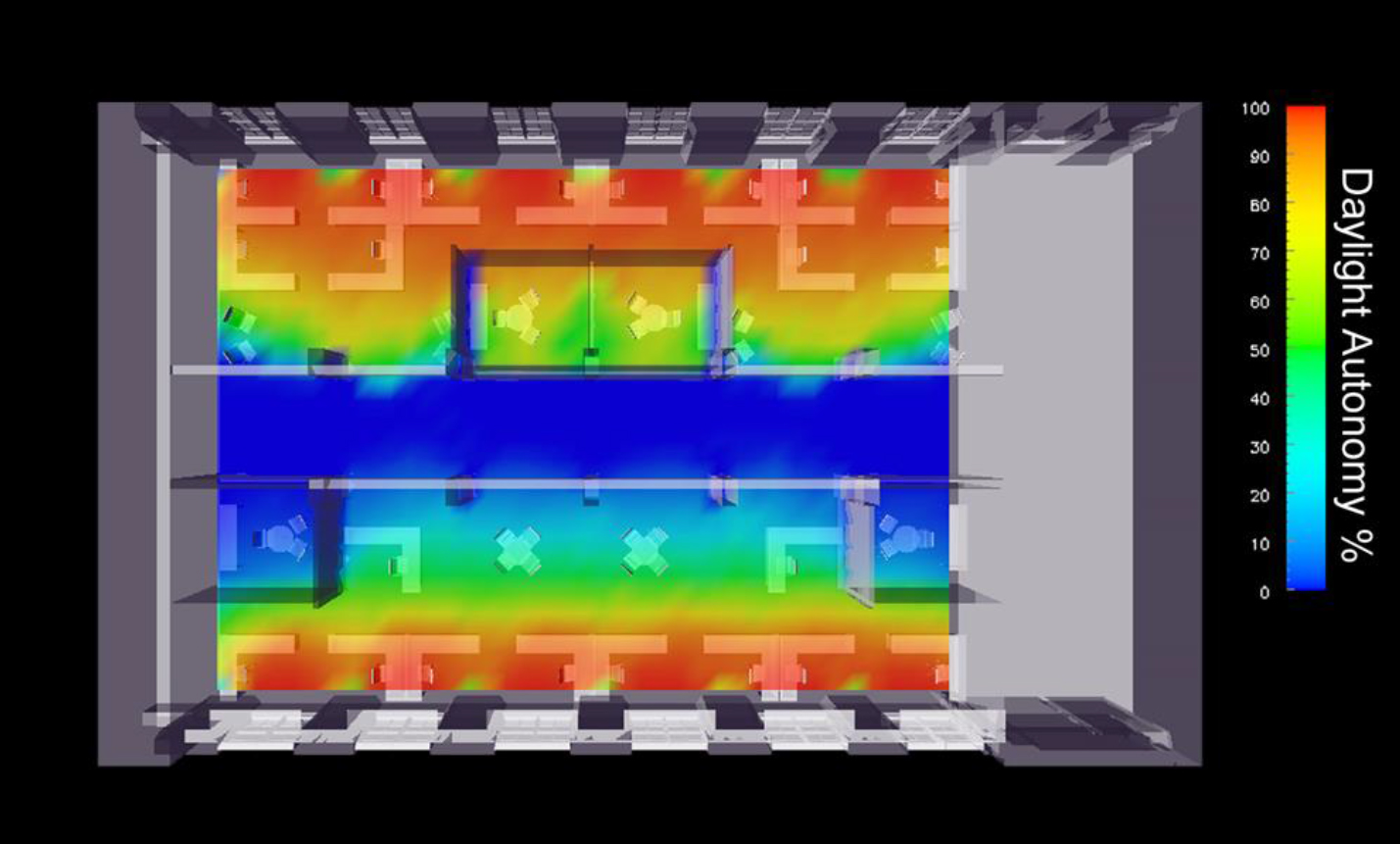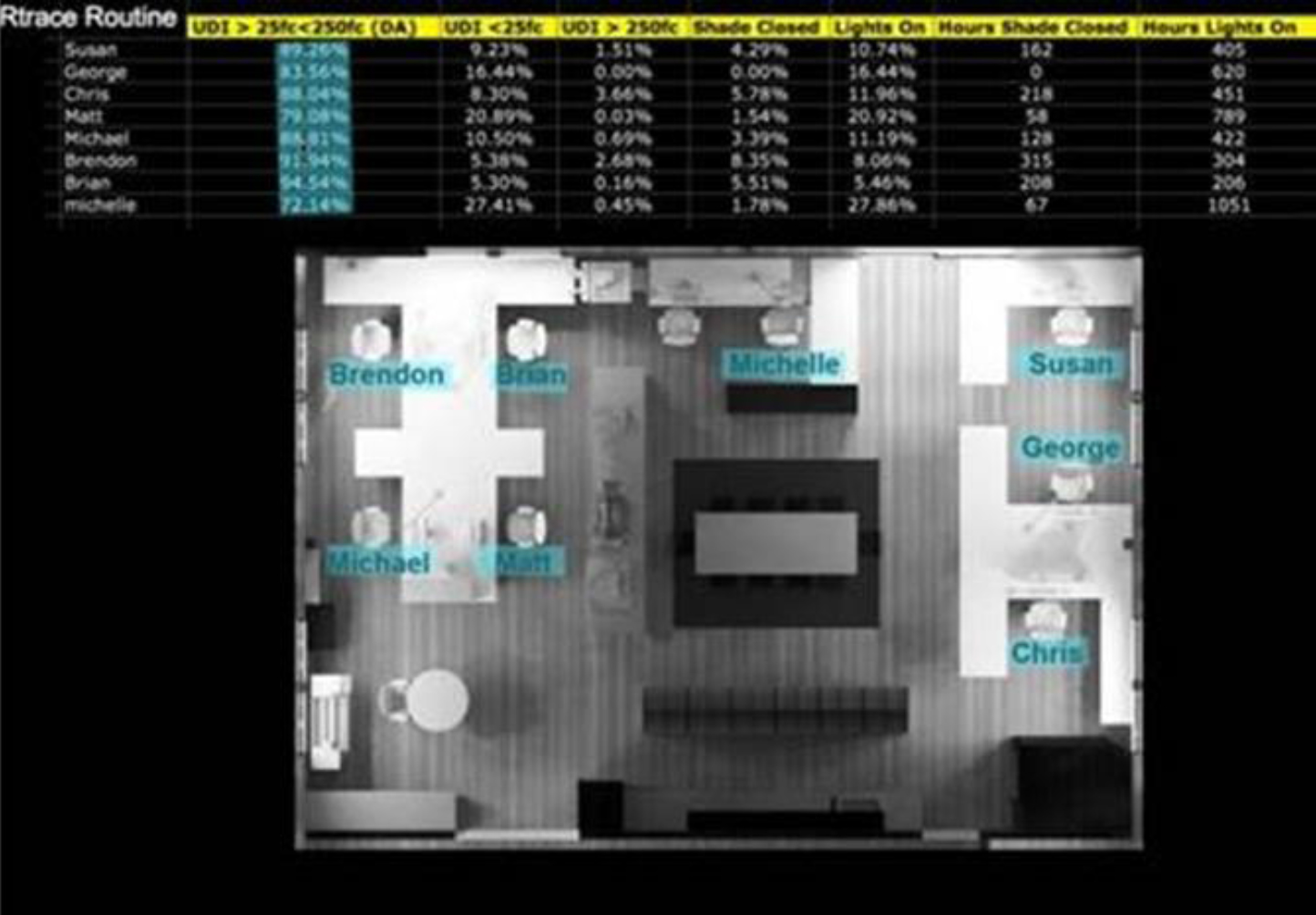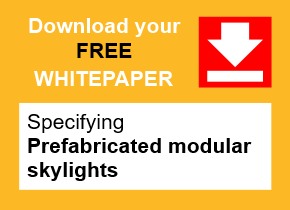The daylight factor
Author: Prof. DTG Strong, B.Sc.(Hons.), D.Phil.(Oxon.), C.Eng. FCIBSE, FEI
Abstract
We spend over 80% of our lives within buildings and numerous research studies have demonstrated that access to daylight has profound implications in terms of human health, happiness and productivity, including; quality of life, happiness and a sense of wellbeing, health (and healing), ability to learn in educational establishments, productivity whilst at work, profitability and shopper-footfall in retail buildings.
The results of an international survey presented in this paper finds that Daylight Factor is the most widely used method of establishing compliance with building code/regulation requirements (and credits within environmental assessment methods such as BREEAM, LEED, Greenmark etc.).
However, Daylight Factor is widely regarded as having serious limitations, since it takes no account of building location, façade orientation and it provides no indication of glare and/or visual comfort. Research suggests that Daylight Factor is of limited value during the Design Stage and compliance with Building Code requirements results in gaming and perverse design outcomes.
Given the profoundly important impact of good daylight design on health and productivity the increasing availability of low cost sophisticated climate based daylight modelling provides an opportunity to replace Daylight Factor.
The paper calls for urgent international collaborative research and agreement to develop standardised methodologies, definitions and metrics associated with climate based daylight modelling. This would enable countries to introduce building code (and building environmental assessment methods) requirements which will result good daylight design and avoid unintended consequences, whilst also providing the basis for compliance assessment.
Introduction
In 2012 the author undertook and published (1) an extensive review of the research findings associated with the health, productivity and wellbeing benefits of daylight in the built environment. Objective evidence supported by empirical data was included in study and this was synthesised & collated into building type/function.
The majority of peer-reviewed research associated with the benefits of daylight, has been undertaken in healthcare and educational buildings, where the body of evidence is clear and compelling. Significant research has also been undertaken associated the workplace and in retail buildings. Surprisingly little research have been undertaken associated with the benefits of daylight in residential buildings. Since a key function of the home is to provide a place to rest and sleep, the paper recommended that further research should be undertaken to determine the health and wellbeing benefits associated with daylight in the home environment.
The key findings demonstrated that in healthcare, access to daylight provides; a reduction in the average length of hospital stay, quicker post-operative recovery, reduced requirements for pain relief, quicker recovery from depressive illness and disinfectant qualities. There is also a growing body of evidence that daylight plays a critically important role in the prevention and treatment of obesity, heart disease and other illnesses exacerbated by stress.
In educational buildings access to daylight has been shown to result in a dramatic (and demonstrable) improvement in student academic achievement, behaviour, calmness and focus.
In the workplace numerous studies identified a preference to work near windows and under conditions which fully utilise natural rather than artificial light. In retail establishments, research shows that a substantial improvement in sales can be achieved in daylit shops.
In buildings of all types, studies show that occupants’ value very highly views from windows (ideally of the natural world). The impact on staff stress reduction, patient outcomes and educational attainment are all clearly established and demonstrably linked to being able to establish a visual link from inside a building to the world outside.
Daylight deprivation in buildings has been shown to have hugely damaging consequences. Without access to daylight the human body-clock becomes disrupted –it needs recalibration on a daily basis and unless we receive adequate daylight, overwhelming medical evidence suggests that humans become stressful and agitated. Any disruption to our circadian rhythm has highly negative consequences in terms of our health, happiness and wellbeing.
The issues associated with daylight deprivation, coupled with a renewed interest in the use of daylight in the design of low-energy, sustainable buildings is leading many architects and engineers to consider innovative ways of exploiting the benefits of daylight (and views) without the negative impacts associated with glare and/or solar over-heating.
This paper presents the results of research to determine the requirements associated with the adequate provision of daylight in buildings internationally. The research undertaken included a survey of built environment specialists and practitioners in 27 countries. The survey asked the following questions:
- Does your country have ‘Right to light’ requirements which safeguard an existing building occupant’s legal right to daylight?
- Does your country have legislative requirements (building regulations, codes, standards or ordinances) specifically related to ensuring adequate daylight provision in new buildings?
- Are you aware of any initiatives to develop international standards associated with daylight provision in buildings?
Responses were received from 16 countries and a more detailed follow-up questionnaire was issued to determine the current barriers to effective daylight utilisation and the priorities (if any) for international collaborative research and/or the development of new international standards.
This paper provides a summary of the key findings, together with an assessment of the implications of using Daylight Factor for assessing compliance with Building Code requirements and/or credits in nationally adopted building environmental assessment methods.
International survey key findings
A detailed analysis of the responses from counties taking part in the survey are available online at: http://www.davidstrong.co.uk/web_documents/international_daylight_survey_results_v.1.xlsx .
Survey responses were obtained from daylight experts and practitioners in the following countries:
- New Zealand
- Switzerland
- Denmark
- Portugal
- Germany
- USA
- Sweden
- Ireland
- UK
- Australia
- France
- China
- Singapore
- Belgium
- South Africa
- Italy
A summary of key findings from the international survey are provided in the following sections:
Rights to light
The survey established that there are common/civil law rights associated with rights to light in; Switzerland, Ireland, Sweden, China (residential, hospitals & nursery schools), Australia, Belgium & UK.
However, the provisions associated with “Ancient Lights” were formally rejected by US courts in 1959 and there is now no common law right to natural light in the USA.
Houses near the Grand Priory Church of the Order of St John, St. John's Square, London (Photo: M Newman)
Legislative requirements ensuring adequate daylight provision in new buildings
Building Code (or Building Regulation) requirements associated with ensuring adequate daylight have been introduced in New Zealand (habitable spaces only), Portugal, Germany, Sweden, Australia (for ventilation), France, China, Singapore and Belgium (dwellings only).
In countries with Building Code requirements associated with daylight, they are generally based on average Daylight Factor and/or minimum window sizes as a % of floor area (and/or wall area).
There are no minimum legal requirement associated with daylight in; Switzerland, Denmark, Ireland, UK, USA and South Africa
However, it is important to note that most countries have (as a minimum) informative codes and standards requiring “sufficient” daylight or illumination, but with mandatory levels not being defined.
International daylight standards
The most widely referenced standards related to daylight are:
- 4.7 Daylight
- BS 8206-2 Lighting for buildings. Part 2: code of practice for daylighting
The existing daylighting standards are informative and are not intended to be applied in a prescriptive manner. For this reason, although being referenced in many national building codes/regulations, the standards are generally used to provide guidance regarding best practice rather than being used for compliance enforcement.
Environmental Rating systems for buildings
The survey identified the increasingly important role (and function) of building environmental rating systems (such as BREEAM, LEED, Greenstar, Greenmark etc.) in establishing and assessing daylight requirements in buildings. In countries where there are no building code requirements associated with daylight, environmental rating systems are increasingly being adopted as the basis of providing de-facto standards.
All the major environmental assessment schemes award credits for daylight. With the execption of special provisions within LEED (see below) credits are generally based on DF (and/or window size as a % of floor area).
However, a number of county experts commented that simplistic methods of awarding credits for daylight (such as average DF, or minimum window size) can result in highly perverse outcomes. This issue is examined in greater detail below.
Other daylight requirements, initiatives & good practice guidance
The EU Workplace (Health, Safety and Welfare) Regulations (1992) requires that “Every workplace shall have suitable and sufficient lighting” and that this lighting “shall, as far as is reasonably practicable, be by natural light”.
However, it is important to note that the terms “sufficient” and “practicable” are not defined. Although the EU Health, Safety and Welfare Regulations are cited in the Building Codes/Regulations of a number of Member States, the absence of a clear definition regarding the specific requirements regarding daylight makes the EU Regulation unenforceable in law. CEN has recently established a Technical Committee to develop daylight metrics.
ASHRAE Standard 90.1 provides good practice design guidelines, as does the CIBSE Lighting Guide 10: Daylighting and Window Design. Country experts noted that the ASHRAE Standard and CIBSE Guide do not provide prescriptive minimum daylight requirements, but do contain useful good practice guidance.
Major international initiatives
Three major collaborative initiatives were identified:
Comité Européen de Normalisation (CEN)
In response to EU Council Directive 89/654/EEC 1989 (minimum safety and health requirements for the workplace) the Comité Européen de Normalisation (CEN) has established a Working Group (11) within Technical Committee 169 to define the metrics used for the evaluation of daylighting conditions and methods of calculation and verification. The metrics will apply to all spaces regularly occupied by people for extended periods.
However, there are concerns that historically achieving EU Member State agreement within CEN can be a highly protracted process and a number of experts observed that pan-European agreement regarding definitions and key metrics was required more urgently than the CEN process was likely to allow. Several observers stated that EU Member States should adopt the metrics developed by the Illuminating Engineering Society (see Section xx), rather than attempting to develop EU specific requirements.
Commission Internationale de l'Éclairage (CIE)
Commission Internationale de l'Éclairage (CIE) has established a Joint Technical Committee (CIE 4 D3/D6 JTC) to review the scientific literature in all relevant fields with the objective of producing a concise document that identifies the values of windows in buildings. Key aspects being considered include: light for visibility, ventilation, means of egress, aesthetic benefits, access to a view, light for physiological functioning, circadian rhythm regulation etc.
The Technical Committee will propose preliminary criteria for daylight metrics and review and contribute to the work being undertaken by CIE TC 3-47.
Illuminating Engineering Society (IES), United States of America
The Illuminating Engineering Society (IES) of America has set itself the mission to develop a “suite” of daylight metrics based upon annual climate-based simulation. The objective is to meet visual needs of occupants (i.e. not primarily energy performance) applicable to common workplace environments, including; open offices, classrooms, meeting rooms, multi-purpose rooms, and service areas in libraries and lobbies, and so are most applicable to areas with similar visual tasks.
To-date the IES have formally adopted/published two metrics
An important development has been the adoption of the IES metrics by the US Green Building Council, with extra LEED credits if LM-83 metrics/modelling is used. This has a significant implications, since it provides a major incentive and stimulus for building designers (& software providers) to consider daylight in a more sophisticated (and holistic) manner than a simple assessment of average Daylight Factor allows.
The implications of using Daylight Factor as the basis for assessing compliance with Building Codes/Regulations and/or Environmental assessment Method Credits.
The survey identified considerable concern amongst daylight experts and practitioners regarding the use of average Daylight Factor (DF) requirements as the basis for assessing compliance with Building Codes/Regulations and/or Environmental assessment Method Credits.
The concept of the DF was first introduced in 1895 by Trotter (2) as one of the indicators for assessing the daylighting performance of a building. Often the DF is expressed as a percentage and is based on the ratio of daylight illumination at a point on a given plane (due to the light received directly or indirectly from a sky of assumed or known luminance distribution) to the illumination on a horizontal plane due to an unobstructed hemisphere of the sky (3).
In the DF the direct sunlight is excluded from both interior and exterior values of illumination. The DF is divided into three components; Sky Component (SC), External Reflected Component (ERC) and Internal Reflected Component (IRC) and the summation of these three gives the total DF.
Typical Daylight Factor analysis
In spite of its popularity as an indicator of daylighting performance, DF has some serious limitations (4);
- DF cannot represent the change in illuminations levels indoors due to the temporal variation of sky luminance
- the orientation of building façade has no effect on DF calculation
- DF does not assess glare caused by daylight
- Glare is a major issue requiring careful consideration during the design stage.
In addition, adopting an average DF as the basis for assessing compliance with Building Code/Regulation requirement (and/or for the award of Environmental assessment Method Credits) has been shown to be:
- open to interpretation and “ game playing”
- sometimes impossible to reconcile criteria for Daylight Factor/Solar penetration and minimisation of solar gains (to avoid air-conditioning requirements)
The main benefit of utilising DF is simplicity and familiarity, however, given the clear and compelling evidence associated with the importance of effective daylight utilisation within buildings a consensus is emerging which suggests that a more sophisticated way of assessing daylight should be adopted in future revisions of national standards and regulations (and environmental assessment methods). Indeed, many specialists suggest that continuing to use DF is resulting in highly perverse outcomes (5).
What are the alternatives to Daylight Factor?
Given the shortcomings associated with DF and the new opportunities offered by Climate Based Daylight modelling (CBDM), many international experts are calling for DF to be replaced with a more sophisticated approach to be adopted in Building Codes (6). The opportunity this would provide includes:
- CBDM provides a basis for considering daylight holistically, based on building location & façade orientation
- The risks associated with solar gains and glare can be accurately assessed
- CBDM enables daylight assessment to be integrated with thermal modelling
- This approach enables an integrative design approach and reduces the risks associated with perverse outcomes (e.g. additional cooling loads resulting from excessive solar gains as a consequence of meeting average DF requirements)
However, any replacement of DF ideally requires international agreement regarding the metrics to be used, together with the adoption of a standardised methodology and the conventions to be adopted by CBDM software providers (7).
It is important to note that CBDM is increasingly being used by many practitioners to assess one (or more) of the following daylight performance indicators:
Daylight Autonomy
Daylight Autonomy (DA) is defined by Harbel & Kota as “a measure of how often a minimum work plane illuminance threshold of 500 lux can be maintained by daylight alone. It is expressed as the percentage of occupied time during the year when a minimum work plane illuminance threshold of 500 lux can be maintained by daylight alone.”
According to Harbel & Kota DA has the following limitations regarding informing the daylighting performance of a building:
- “Daylight Autonomy fails to give significance to those daylight illuminances that are below the threshold (for example, 500 lux), but which are nevertheless valued by occupants and may also have the potential to displace all or part of the electric lighting loads.”
- “DA makes no account of the amount by which the threshold illuminance was exceeded at any particular instant, which can inform about glare and thermal discomfort”
Typical Daylight Autonomy (Image courtesy of Loisos + Ubbelohde)
Useful Daylight Illuminance
A recently developed daylight performance indicator is the Useful Daylight Illuminance (UDI). Nabil & Mardaljevic (8) state that “UDI addresses some of the issues related to DF and DA. It is a climate based analysis, and represents the indoor illumination distribution for a whole year as a function of outdoor time-varying sky and sun conditions. UDI not only provides information about useful daylight illuminance, but also on the propensity for excessive levels of daylight that are associated with glare, occupant discomfort and unwanted solar gains.”
Useful Daylight Illuminance (Image courtesy of Loisos + Ubbelohde)
Cumulative illuminance
Obtaining international (or even European) agreement to the conventions to be used associated with DA and/or UDI as possible replacements for DF has resulted in Mardaljevic et al proposing that CEN Technical Committee 169 adopt an interim approach for use within the EU based on cumulative illuminance.
Cumulative Illuminance (CI) combines some of the simplicity of DF with CBDM. CI determines the annual occurrence for illuminance based on the cumulative availability of diffuse illuminance from standardised climate files. Mardaljevic suggests a possible target of 300 lux across half the work- plane for half the year when sun is above the horizon. This approach is less sophisticated than UDI (and does not allow glare to be assessed but does enable location specific DF’s to be set as the basis of a Building Code compliance requirement (and/or for awarding credits in environmental assessment methods).
Conclusion
The results from the international survey presented in this paper suggest that the legal requirements and regulations regarding daylight are very diverse. In the case of most countries the requirements are generally only advisory and are not prescriptive. However, a growing body of objective and empirical evidence confirms that daylight is a fundamentally important human health, productivity issue.
Most international experts agree that an urgent need exists to develop robust international y agreed metrics, conventions & methodologies to enable robust and effective daylight compliance requirements to be established for adoption within building codes and regulations at the country level.
It is widely accepted that the use of Daylight Factor as the basis for establishing and assessing compliance is of limited value and can result in highly perverse outcomes, often leading to a poor internal environment with high levels of glare and/or excessive cooling demands.
The next generation of building Codes and Regulations (and Environmental Assessment Methods) requires daylight to be considered holistically, including; building location, façade orientation, visual comfort, glare and aesthetic considerations together with the energy related implications.
Nearly all building designers have access to sophisticated CAD modelling and analysis tools. Given the importance of daylight in terms of human health, productivity, happiness and wellbeing, it is suggested that DF should be replaced with CBDM derived daylight indicator(s). This will help deliver outcomes which provide an optimum use of daylight, whist minimising energy requirements for artificial lighting and/or cooling. Utilising CBDM also enables the risks associated with glare and visual comfort within buildings to be accurately assessed and mitigated.
Acknowledgement
The author gratefully acknowledges support provided by Glass for Europe and VELUX which enabled the research summarised in this paper to be undertaken.
This paper was entered into a competition launched by --BRE Group and UBM called to investigate the link between buildings and the wellbeing of those who occupy them.
Other definitions
Average daylight factor
NB The average daylight factor is: 'the average indoor illuminance (from daylight) on the working plane within a room. This is expressed as a percentage of the simultaneous outdoor illuminance on a horizontal plane under an unobstructed CIE Standard Overcast Sky.' Ref Commission Internationale de L’Eclairage (International Commission on Illumination). CIE Standard 011/E:2003
Point daylight factor
'...expressed as a percentage based on the ratio of the daylight illuminance at a specific point on the working plane within a room compared with the illuminance on an outdoor unobstructed horizontal plane. An overcast sky is assumed by the ‘CIE (Commission Internationale de l’Eclairage) overcast sky’. For points on the working plane:
- Minimum point daylight factor is the lowest value daylight factor at a point that is not within 0.5m of a wall.
- Minimum illuminance is illuminance at the worst lit point that is not within 0.5m of a wall.
- These points usually occur close to a rear corner of the room. Computer simulations are the most appropriate tools to allow for point daylight factors and illuminances to be calculated.'
Ref BREEAM UK New Construction, Non-domestic Buildings (United Kingdom), Technical Manual, SD5078: BREEAM UK New Construction 2018 3.0, published by BRE Global Limited.
References
- 1 The social and economic contributions of glazed areas to sustainability in the built environment Prof. DTG Strong 12th Nov. 2012 Report published by Glass for Europe.
- 2 Walsh, J.W.T. 1951. The early years of Illuminating engineering in Great Britain. Transactions of the Illuminating Engineering Society 15(3): 49-60.
- 3 James, A.L. 1992. The Evolution of Performance Indicators for the Evaluation of Daylighting Systems. Industry Applications Society Annual Meeting, Conference Record of the 1992 IEEE, Houston, April 10th.
- 4 Haberl, J.S. Kota,S - Proceedings of the Ninth International Conference for Enhanced Building Operations, Austin, Texas, November 17 - 19, 2009
- 5 J. Mardaljevic. Rethinking daylighting and compliance. Journal of Sustainable Engineering Design, 1(3):2–9, 2013
- 6 M. Andersen, J. Mardaljevic, and S. W. Lockley. A framework for predicting the non-visual effects of daylight - Part I: photobiology-based model. Lighting Research and Technology, 44(1):37–53, 03 2012
- 7 J. Mardaljevic, M. Andersen, N. Roy, and J. Christoffersen. A framework for predicting the non-visual effects of daylight - part II: The simulation model. Lighting Research and Technology, 06 2013
- 8 Nabil, A., Mardaljevic, J. 2006. Useful daylight illuminance: A replacement for daylight factors. Energy and Buildings. 38(4) 905-913.
Related articles on Designing Buildings
- Artificial lighting.
- Aspects of daylighting design covered by EN 17037.
- BRE Expert Collection 6 Daylight and shading.
- Colour.
- Colour Rendering Index CRI.
- Daylight benefits in healthcare buildings.
- Daylight lighting systems.
- Daylit space.
- Designing daylight solutions for commercial buildings.
- EN 17037 Daylight in buildings.
- General lighting v task lighting.
- Guiding light: Unlocking London's residential density.
- Lighting.
- Lighting and health infographic.
- Lighting of construction sites.
- Lux.
- Non-domestic building services compliance guide.
- Solar shading
- The daylight factor.
- Types of building EN 17037 applies to.
- Uniformity of illuminance.
- Working plane.
Featured articles and news
Infrastructure that connect the physical and digital domains.
Harnessing robotics and AI in challenging environments
The key to nuclear decommissioning and fusion engineering.
BSRIA announces Lisa Ashworth as new CEO
Tasked with furthering BSRIA’s impressive growth ambitions.
Public buildings get half a million energy efficiency boost
£557 million to switch to cleaner heating and save on energy.
CIOB launches pre-election manifesto
Outlining potential future policies for the next government.
Grenfell Tower Inquiry announcement
Phase 2 hearings come to a close and the final report due in September.
Progress from Parts L, F and O: A whitepaper, one year on.
A replicated study to understand the opinion of practitioners.
ECA announces new president 2024
Electrical engineer and business leader Stuart Smith.
A distinct type of countryside that should be celebrated.
Should Part O be extended to existing buildings?
EAC brands heatwave adaptation a missed opportunity.
Definition of Statutory in workplace and facilities management
Established by IWFM, BESA, CIBSE and BSRIA.
Tackling the transition from traditional heating systems
59% lack the necessary information and confidence to switch.
The general election and the construction industry
As PM, Rishi Sunak announces July 4 date for an election.
Eco apprenticeships continue help grow green workforce
A year after being recognised at the King's coronation.
Permitted development rights for agricultural buildings
The changes coming into effect as of May 21, 2024.








